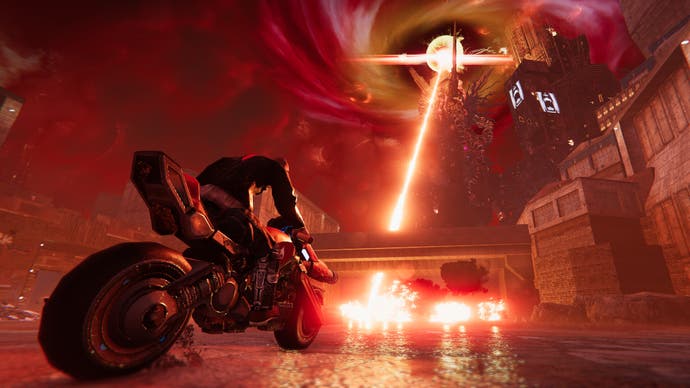Turbo Overkill review - the new cyber-god of retro shooters
Boom eternal.
I'd say that Turbo Overkill is the best boomer shooter I've played, but I'm still figuring out whether it counts as a boomer shooter at all. Like its cyborg protagonist, much of Turbo Overkill's core DNA has been augmented with newer, shinier design ideas. It borrows as much from games like Doom Eternal and Titanfall 2 as it does from the classics of the nineties. It has upgradable weapons, character perks, driveable vehicles, detailed first-person cutscenes, all played out on a scale that simply wouldn't have been possible back in 1997.
Either way, what matters is this: Turbo Overkill is fucking amazing. Its specific combination of past and present produces a riotously entertaining gunfest where "Escalation" isn't so much a storytelling technique as it is a lifestyle choice. It is wholly committed to being as cool, colourful and creative as it possibly can, a game that starts by putting a chainsaw in your leg and ends with the goddamn techopalypse.
Your avatar for this ballistic rollercoaster is the wonderfully named Johnny Turbo. A bounty hunter living in a typically gaudy cyberpunk future, Johnny returns to his home city of Paradise to find it literally riddled with Syn. I don't mean the concept of religious transgression, although there's plenty of that in Paradise too. No, Syn is one of those malevolent AIs that dystopian futures keep foolishly creating, with freshly installed delusions of godhood and a psychotic desire to assimilate all organic and synthetic life. The result is a neon metropolis infested with writhing fleshy tendrils, guarded by hordes of mutilated humans with TVs for heads.
Turbo Overkill wastes no time getting to the good stuff. Your starting weapon is not some pathetic pea shooter, but a pair of twin laser pistols that make a gratifying mess of most basic enemies. The alt-fire, meanwhile, locks onto to multiple targets as it charges. When released, it fires at every targeted foe simultaneously, turning them to mince as Johnny blows on the smoking hot barrel.
Johnny's twin pistols are a winning aperitif, but his signature weapon isn't held in his hands. Pressing Control will propel Johnny into an aggressive slide, revealing the snarling chainsaw blade concealed inside his leg. Using this, Johnny can tear around the ground at blistering speed, shredding enemies in front of him into slop. It's a wicked gimmick and Turbo Overkill knows it, frequently arranging levels to help you get the best from it. See a narrow corridor crammed with oblivious goons? It's Chegg o'clock, baby.
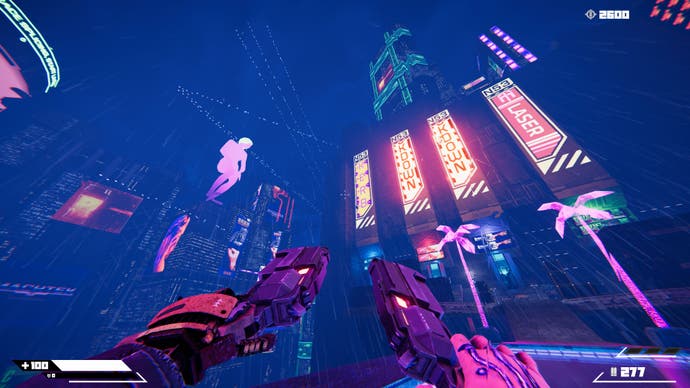
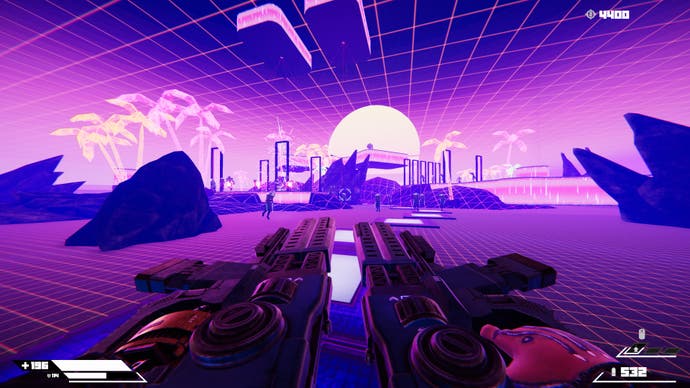
Even at this basic level, there's a distinctive quality to Turbo Overkill's gunplay. But this is only the start. Within minutes, you pick up a pulse-shotgun with a delicious triple-pump alt-fire that launches an stun-locking orb great for immobilising larger opponents. A few levels later, you pick up a chaingun to rival Prodeus' meat-mulcher that also doubles as a flamethrower. The two best weapons are picked up halfway through the game. The first is a telefragging sniper rifle, which, as the name implies, lets you murder enemies by teleporting yourself into them. While enticing, it's limited by the fact that you can only telefrag basic enemies. But the rifle redeems itself through its unlockable upgrade, which lets you charge the primary fire into a ferocious railgun blast that will obliterate nearly anything.
Then there's the Ion Cannon, which is a more freeform knockoff of the Hammer of Dawn from Gears of War. Aside from its apocalyptic alt-fire, what I love about the Ion Blaster is how it handles ammo. Rather than loading it with projectiles, you instead collect tickets that let you "rent" use of the orbiting satellite from which the Ion Cannon laser pummels down. In that sense, it's the most cyberpunk of all Turbo Overkill's weapons, an Armageddon-level weapon that you can borrow like a vacuum cleaner.
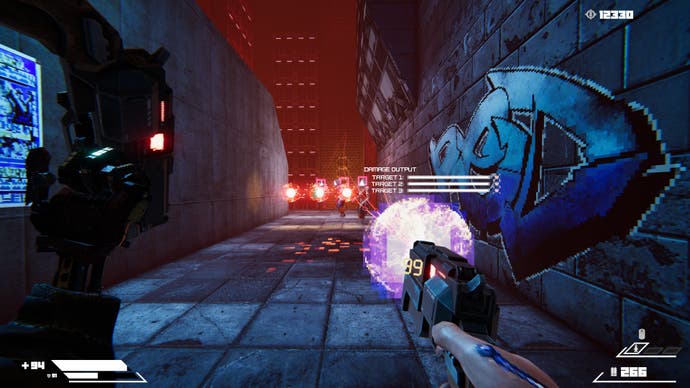
This gives you a sense of the power curve Turbo Overkill plays with. What it doesn't communicate is how kinetic all of this is. Alongside his Chegg-slide and meat-based teleport, Johnny can also dash, double jump, and run along certain walls to evade enemies and cross gaps. You spend almost as much time fighting in the air as on the ground, dashing, leaping and bouncing off enemies to maintain altitude while you rain hell on your opponents below.
There is a price for this mechanical variety, and it's paid in a slight lack of refinement. Certain weapons like the sawed-off "boomer" shotgun could be weightier, while the ability to run along walls lacks tactility compared to games like Titanfall and Jedi Survivor. There's a fantastic-sounding upgrade that triggers an explosion whenever you land from a height. But the effect is almost silent, to the point where you might forget you have it installed, and wonder why all the enemies you landed amidst suddenly turned to mince.


Moreover, the default difficulty skews too far toward easy. Given there are five difficulty settings, this shouldn't be a problem. But you can't increase the challenge once you've started a game, only decrease it. It's a shame, as there are some superbly grim enemy designs here, such as an electrical adversary with a body split in two by the mechanical exoskeleton they're wearing, and an a hideous creature called the "Technopede" with a neck made from human torsos that fires green lasers from its eye. But the impact of these foes becomes trivialised at easier difficulties, so ensure to start as hard as you can handle, then work your way down.
I've no idea how you'd make a sequel to this, but I'd sure as hell like to see Trigger Happy try.
Yet like all the best shooters what elevates Turbo Overkill is the journey it takes you on. In classic shareware style, Turbo Overkill splits the action into three chapters, each wildly different from the one preceding it. The first is the most typically cyberpunk, with you seeking to rip out Syn's infestation by the cybernetically amalgamated arteries. The first few levels are all great fun, but the action kicks up a notch when you need to break into a bank vault to purge Syn's infestation from the sector, which involves a fight in a holographic nightclub that looks like someone tried to render GTA: Vice City in Tron. This is immediately followed by a scintillating homage to the 2012 movie "Dredd" as you battle through the gigantic "Appletrees" tower block from basement to rooftop. The highlight of the chapter sees you piloting your hovercar between three cloud-piercing skyscrapers, blasting the rooftops from above with rockets and gatling fire before leaping out to continue the battle on foot.
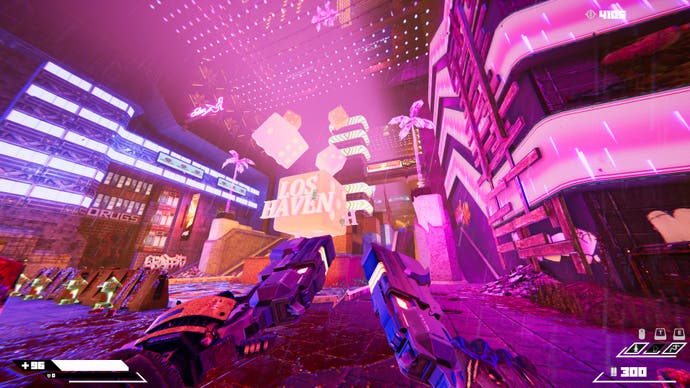
The second chapter is the weakest of the three, with the game reaching its nadir in the overlong green haze of the chapter's second level "Toxic Refinery". But this middle act redeems itself with possibly the best level in the game, Exodus, a thrilling escape from the white-hot wrath of Syn on an Akira-style motorcycle. The third chapter, meanwhile, is all gravy. Its only weakness is an overlong finale, and it feels overlong mainly because it's preceded by several levels that could easily have been finales. The first of these "Infestation" begins as a riff on the opening scenes of Terminator 2, before slowly turning into Doom Eternal's Super Gore Nest. The second, Terminal Eclipse, launches the fighting into space, and has you dashing between multiple doomed spacecraft via floating chunks of planet.
It's a wild ride. You might complain that Turbo Overkill's best moments are often playable references to other media, though you could level the same at much higher profile titles, from Max Payne to Call of Duty. I'm also unsure how coherent the story is. By the end I'd lost track of why I was fighting, although given the cynicism at the heart of cyberpunk, I don't think that's entirely accidental.
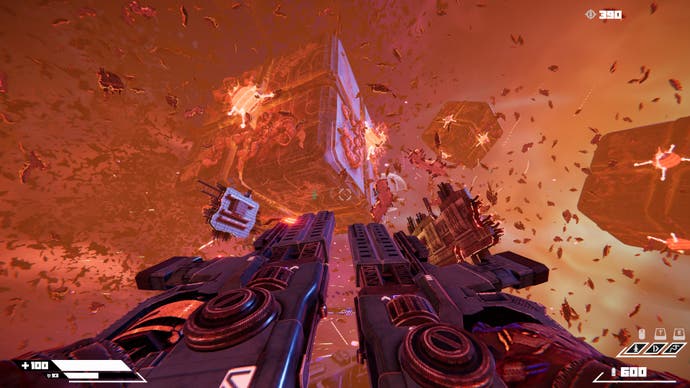
In any case, the overarching plot is far less of a concern here than the moment-to-moment, and Turbo Overkill has so many spectacular, shocking, and outright daft moments. From flipping off enemies as you launch a barrage of mini-rockets from your left arm (oh yeah, you can launch mini rockets from your left arm), to entering a level by using an enemy's intestines as a rappelling rope. It packs more weird, nasty fun into a twelve-hour window than anything else I've played this year. I've no idea how you'd make a sequel to this, but I'd sure as hell like to see Trigger Happy try.
I take back what I said at the start. Turbo Overkill is the best boomer shooter I've played, and I know exactly where it would fit in the alternate timeline imagined by the genre. This is a game you might have seen if Daikatana was good, or if 3D Realms had realised the potential in that unforgettable 2001 trailer of Duke Nukem Forever. It represents that next level shooters aspired to before Call of Duty happened: glorious, excessive, relentless fun.
